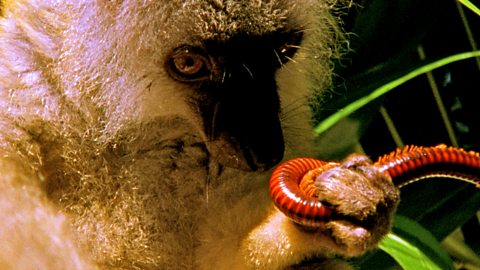The natural world is full of surprises, and among the most intriguing is the tendency of some animals to seek out and enjoy psychoactive substances. While the image of humans indulging in recreational drugs is all too familiar, it might come as a surprise that certain animals also partake in mind-altering activities. One fascinating example is the black lemurs of Madagascar, who have developed a unique method of getting high.
Black Lemurs:
Black lemurs in Madagascar have a peculiar habit that looks like something straight out of a wild party. These lemurs capture large red millipedes and gently bite them, triggering the millipedes to release defensive secretions. These secretions, which include cyanide and benzoquinone, serve as a chemical weapon for the millipedes but have a very different effect on the lemurs.
When the lemurs bite the millipedes, they begin to salivate and then rub the millipede secretions, mixed with their own saliva, all over their fur. This process provides the lemurs with pleasurable psychoactive effects, akin to a human taking a hit from a bong. Interestingly, this behavior has a dual purpose. While the lemurs get their high, the secretions also act as an insecticide, protecting them from parasites. Both male and female lemurs, regardless of their color, indulge in this activity, often looking a little worse for wear by the time they've had their fill.
Jaguars and Yagé:
Moving from primates to big cats, jaguars in the Amazon are known to seek out the yagé vine, also known as Banisteriopsis caapi. This vine contains potent hallucinogenic compounds used by indigenous peoples in their spiritual rituals. Jaguars, however, seem to chew on the vine not for spiritual reasons but for the intense hallucinogenic experience it provides.
The jaguars' consumption of yagé leads to altered states of perception and behavior. Researchers speculate that this might help the big cats sharpen their hunting skills, enhancing their sensory perceptions. The exact reasons remain a mystery, but the sight of a jaguar seemingly lost in a psychedelic trance is a testament to the wide appeal of natural psychoactive substances.
Reindeer and Fly Agaric:
In the frozen expanses of the Arctic, reindeer have discovered a different kind of high. These animals are known to seek out and consume the fly agaric mushroom (Amanita muscaria), which contains powerful psychoactive compounds like muscimol and ibotenic acid. These mushrooms induce states of euphoria, hallucinations, and altered behavior in reindeer.
Indigenous Sami herders have long observed this behavior and have even followed suit by consuming the urine of these reindeer to experience the mushrooms' effects. The reindeer themselves exhibit unusual behavior after consuming the mushrooms, often running in circles and making strange noises. This seemingly bizarre activity might have a purpose related to stress relief or even social bonding among the herd.
Dolphins and Pufferfish:
Marine life isn’t exempt from this trend either. Dolphins have been observed engaging in what appears to be recreational drug use involving pufferfish. These fish release a potent neurotoxin called tetrodotoxin when threatened. In controlled doses, this toxin can produce narcotic effects.
Dolphins have been seen gently handling pufferfish, passing them around among members of their pod. They seem to enter a trance-like state, floating just below the surface, often with a blissful expression on their faces. This behavior suggests that dolphins are aware of the pufferfish’s effects and deliberately use them to experience these pleasurable sensations.
Wallabies and Poppy Fields:
In Australia, wallabies have developed an unexpected penchant for poppy fields. These marsupials have been observed raiding fields of opium poppies, used for pharmaceutical purposes. The poppies contain opiates that have powerful psychoactive and addictive properties.
After consuming the poppies, wallabies exhibit behavior akin to intoxication. They hop around erratically, often creating crop circles in the process. Farmers frequently find these dazed and confused wallabies lying around their fields, high on the poppies' potent alkaloids. This unintended consequence of poppy farming highlights the broad spectrum of animals that can fall under the spell of natural intoxicants.
The behavior of these animals highlights the intriguing ways in which different species interact with natural psychoactive substances. Whether for pleasure, stress relief, or even medicinal purposes, the reasons behind these behaviors are as varied as the animals themselves. The natural world is a place of wonder and mystery, and these examples offer a glimpse into the often-overlooked aspects of animal behavior.
